| |
|
The name of this
village will be familiar to many, for RAF Honington was
in its day one of East Anglia's busier airbases. In fact,
the base lies a mile or so west of the village, and the
main thing that disturbs the peace here is the busy
A1088, which scurries through on its way from Ixworth to
Thetford. This is not a cyclists' road, but you can get
off it onto some of the quietest, loneliest lanes in all
East Anglia.
The church is off the main road, down what was once the
high street, among old houses which have been carefully
restored. In one of these, the poet Robert Bloomfield was
born. Little-known today, his work The Farmer's Boy
was a publishing sensation at the start of the 19th
century, thanks to the attentions of the influential
radical lawyer and writer Capel Llofts of neighbouring
Troston. It sold more than 26,000 copies in less than
three years. It is hard to imagine a poet today selling a
tenth as much. There is a memorial to Bloomfield inside
the church.
This is not a big church, smaller and prettier than
Troston. What they both share is a beautiful porch,
replete with flint flushwork and Marian iconography,
completed on the eve of the Reformation. This is the
devotional English Church at perhaps its highest point.
But this church is a much older one than its porch, as
you see as you go through the outer doors, and find the
great Norman doorway. It is one of the half dozen best in
all Suffolk, and similar to that at nearby Sapiston, more
awe-inspiring, perhaps, although less beautiful.
Inside, all is neat, bright and devotional. You might
even think it a little tame and polite, after the
grandeur of the porch, the mystery of the doorway. With
its plastered ceilure, the grand Norman chancel arch is a
rather curious thing. You could be forgiven for thinking,
for a moment, that it is an 18th century classical
conceit. However, despite its domestication, Honington
church has a couple of splendid survivals. One is the
14th century font. It has familiar tracery patterns on 7
sides, but the 8th has a heart-achingly lovely
crucifixion scene. Above the cross are the sun and moon
in the sky, and Mary lifts her hands imploringly, while
John holds his head in despair. The other great treasure
is at the other end of the church, for although Honington
suffered one of Suffolk's very last destructive
restorations, when all the medieval benches were removed
on the eve of World War I, some of the bench ends
survived. They have been incorporated into the choir
stalls in the chancel. Here you'll find Honington's
famous bagpiper, the quality suggesting that he is part
of the body of work of the same carver at Ixworth
Thorpe.As I often say, probably too often, if these
medieval art objects were in the V&A, people would
travel to London from all over England just to see them.
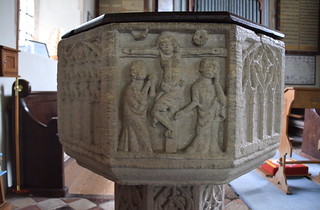 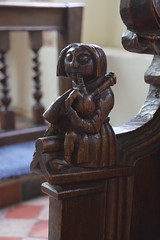
The most significant
new addition to churches in the last two decades has been
a series of millennium windows, although as I have said
elsewhere there seems to have been a loss of nerve among
stained glass designers, and the bold, confident designs
of the previous half a century was replaced by a certain
kitschiness, a loss of nerve perhaps. Some of the windows
appear to have been designed by a commitee, cramming in
as many aspects of parish life as possible without an
over-arching focus. However, at Honington the window
transcends this difficulty, a lovely boiling of images
from the joint parish of Honington and Sapiston,
including wildlife, farming on the Euston estate, the
airbase, and the vicar standing outside the Norman
doorway of her church. The River Blackbourne trickles
through it all. The artist, of course, was Pippa
Blackall, who I think quite the most significant stained
glass artist working in East Anglia over the last thirty
years.
  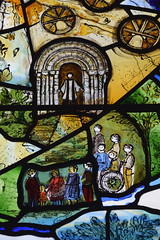 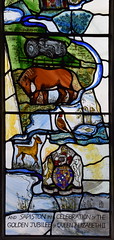 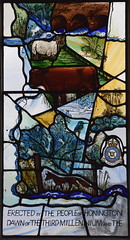
Sam Mortlock bemoans
the whitewashing of the wall paintings that Munro Cautley
saw here in the 1930s. One of them was of St Thomas of
Canterbury, a rare survival, since he was violently
excised by the Anglican reformers. Of course, the
whitewashing was probably an expedient measure, to
protect them until such a time as there was money and a
will to restore them. When Cautley saw them, they were
already faded.
Simon
Knott, July 2019
Follow these journeys as they happen at Last Of England
Twitter.
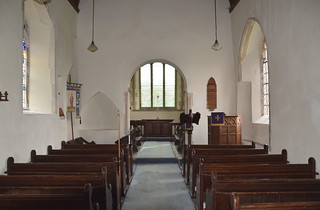
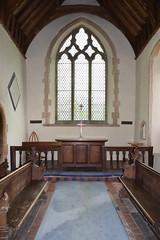  
  

| |
| |
|
|
|
|
|
|
|
| |
|
|
|
|
|
|
|
|
The Churches of East
Anglia websites are
non-profit-making. But if you
enjoy using them and find them
useful, a small contribution
towards the costs of web space,
train fares and the like would be
most gratefully received. You can
donate via Paypal.
|
|
|
|
|
|
|
|
|
|
|
|
|
|
|
|
|
|
|
|
|
|
|
|
| |
|
|
|
|
|
|
|
|
|
|
|
|
|
|
|
|
|

